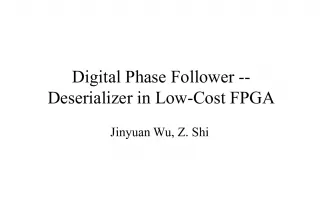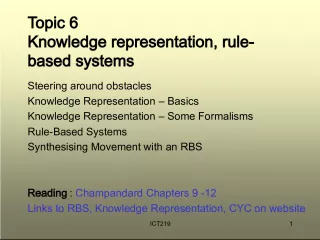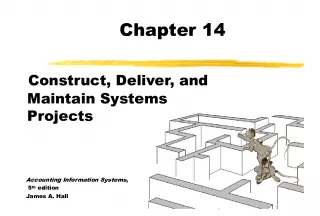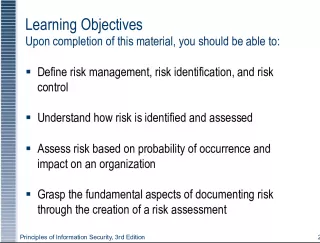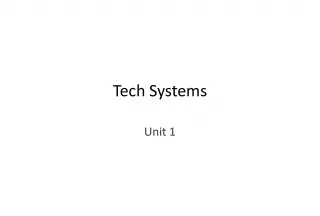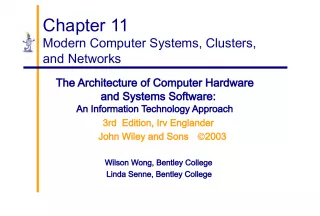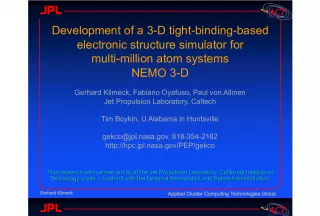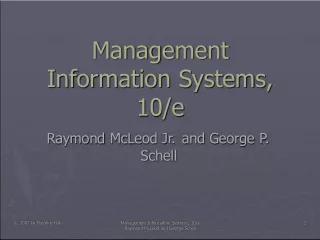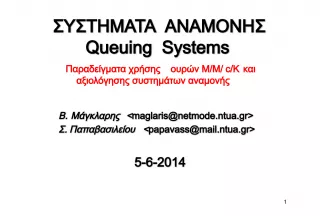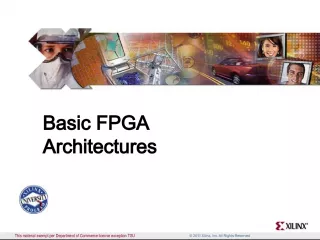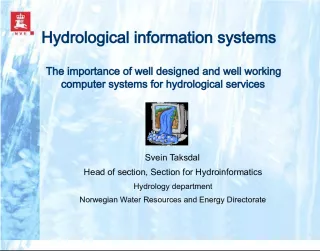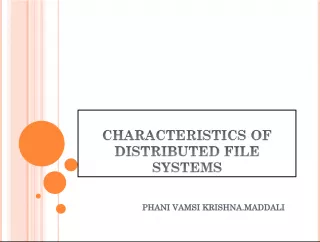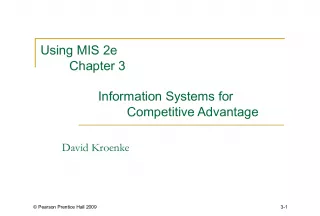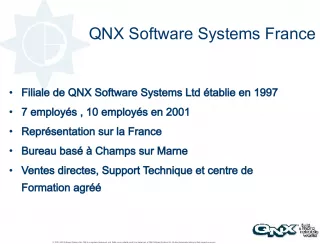SEU Mitigation for FPGA based Systems
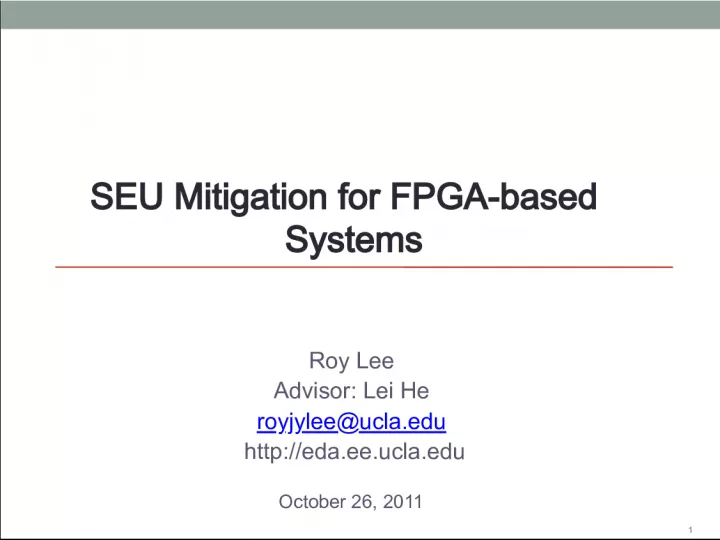

This article, written by Roy Lee (Advisor) and Lei He (royjylee@ucla.edu), discusses the challenges and solutions for mitigating Single Event Upsets (SE
- Uploaded on | 2 Views
-
 cecilmitchelle
cecilmitchelle
About SEU Mitigation for FPGA based Systems
PowerPoint presentation about 'SEU Mitigation for FPGA based Systems'. This presentation describes the topic on This article, written by Roy Lee (Advisor) and Lei He (royjylee@ucla.edu), discusses the challenges and solutions for mitigating Single Event Upsets (SE. The key topics included in this slideshow are . Download this presentation absolutely free.
Presentation Transcript
Slide1Roy LeeAdvisor: Lei He royjylee@ucla.edu http://eda.ee.ucla.edu October 26, 2011 1 SEU Mitigation for FPGA-based Systems
Slide2Outline• Introduction • In-Place Decomposition (IPD) • In-Place LUT Polarity Inversion (IPV) • Experimental Results • Conclusions & Future Works
Slide3Robustness in FPGAs• FPGAs are extensively used not only for prototyping but also in a wide range of applications such as internet networking and communication equipment, and robustness is among the most important design objectives • An effective approach for reducing the impact of Single Event Upset can lead to higher mean-time-to- failure(MTTF), increased quality of service, and reduced maintenance cost
Slide4Single Event Upset (SEU)• Single Event Upsets (SEUs) : one of the main causes of reliability reduction caused by charge particle strikes due to cosmic radiation which create soft errors • Major effect on circuits : change the logic state of a static memory element • Trend : SEU vulnerability is increasing with technology shrinking
Slide5SEU in FPGAs• Most of the commercial FPGAs employ SRAM as their configuration memory elements for higher logic density and programming flexibility • Three of the major memory elements in FPGAs : user flip-flop, block RAM, and configuration RAM
Slide6Single Event Upset in FPGA• The circuit effect of SEUs in a FPGA is permanent until the FPGA is re-programmed Interconnect : Logic : SEU on Configuration RAM is much more critical! SEU on Configuration RAM is much more critical!
Slide7Demand for In-Place Reliability Optimizations• Triple Modular Redundancy (TMR) is the most popular fault tolerant technique, but it requires more than 3X overhead on power, area, and cost • For non-mission critical applications, such as communication systems, robustness improvement with little or no overhead is highly demanded • In-place optimization techniques provide reliability improvement while preserving circuit placement and routing, and therefore the overhead is minimal
Slide8In-Place Resyntheses Flow• Mitigation after placement and routing without change of placement and routing (and no change on design closure) Design Entry Logic Synthesis Map Bitstream Placement and Routing In-Place Decomposition (IPD) In-Place LUT Polarity Inversion (IPV) In-Place Resyntheses
Slide9Outline• Introduction • In-Place Decomposition (IPD) • In-Place LUT Polarity Inversion (IPV) • Experimental Results • Conclusions & Future Works
Slide10Fault Metrics• Soft Error Rate(SER) of a configuration SRAM bit: • Mean-Time-To-Failure (MTTF) • System level measurement of reliability • For single fault model, MTTF 1/average( SER b )
Slide11In-Place LUT Decomposition• Leveraging the dual-output feature of LUT architecture and the built-in carry chains Dual-output 6LUT Dual-output 6LUT Xilinx Virtex-5 6-input LUT architecture
Slide12 Original LUT Decomposed LUT Decomposition LUT Decomposition • Decomposition : F = C( F1, F2, ……, Fn ) (C is the converging logic function)
Slide13Example 1 : In-Place Duplication• The average SER of the LUT is : ( S 0 +……+ S 31 )/32 5 -input AND function Input Output SER 00000 0 S 0 00001 0 S 1 00010 0 S 2 11110 0 S 30 11111 1 S 31 …… …… 5 -input ……
Slide14InputOutput SER 00000 0 S 0 00001 0 S 1 00010 0 S 2 11110 0 S 30 11111 1 S 31 • The average SER of the LUT is reduced to (2* S 31 )/32 Covered …… 0 -> 1 0 …… …… Input Output SER 00000 0 S 0 00001 0 S 1 00010 0 S 2 11110 0 S 30 11111 1 S 31 …… …… …… Covered Example 1 : In-Place Duplication
Slide15InputOutput SER 000 0 AS 0 001 0 AS 1 110 0 AS 6 111 1 AS 7 • The number of SRAM bits used is reduced from 32 to 12, and the SERs of unused bits are 0 • The average SER is also reduced due to logic masking of the converging logic …… …… …… Input Output SER 00 0 BS 0 01 0 BS 1 10 0 BS 2 11 1 BS 3 Example 2 : In-Place Decomposition
Slide16Outline• Introduction • In-Place Decomposition (IPD) • In-Place LUT Polarity Inversion (IPV) • Experimental Results • Conclusions & Future Works
Slide17Fault Masking for MUX• Fault is masked when logic( i ) = logic( j ) SEU on a routing MUX
Slide18Example of Fault MaskingSER( b k )=( v ( i ) v ( j ) ) · observ ( m ) observ ( m ) is the fault observability a t MUX m : the probability of the fault that can be propagated to the primary outputs
Slide19LUT Polarity InversionPolarity can be determined independently for each input and the output of an LUT LUT inversion Fanout adjustment
Slide20Inversion to Reduce SERSER: 1-0.9*0.2- 0.1*0.8=0.74 SER: 1-0.9*0.8- 0.1*0.2= 0.26
Slide21Outline• Introduction • In-Place Decomposition (IPD) • In-Place LUT Polarity Inversion (IPV) • Experimental Results • Conclusions & Future Works
Slide22Improvement by IPDLUT-Level Chip-level ABC IPD ABC IPD alu4 0.34% 0.11% 0.45% 3.23% apex2 0.29% 0.04% 0.33% 2.67% apex4 1.16% 0.25% 1.41% 10.63% des 1.42% 1.01% 2.43% 13.95% ex1010 1.24% 0.29% 1.53% 11.60% exp5p 0.73% 0.24% 0.97% 7.06% misex3 0.55% 0.10% 0.65% 5.08% pdc 0.91% 0.11% 1.02% 8.51% seq 0.63% 0.11% 0.74% 5.78% spla 1.14% 0.16% 1.30% 10.67% SER Ratio 1.00 0.22 1.00 0.94 MTTF Imp. 1.00 4.52 1.00 1.07 IPV increase LUT-level MTTF by 4.52x, and chip-level MTTF by 1.07x (due to dominance of interconnects) SER reduction for MCNC benchmarks mapped to 6-input LUTs
Slide23Improvement by IPVIPV on average increases chip-level MTTF by 3.07X Less than 50% LUTs need to be inverted Interconnect Chip-level ABC IPV ABC IPV alu4 3.06% 1.54% 3.40% 0.88% apex2 2.61% 0.70% 2.90% 1.04% apex4 10.44% 2.13% 11.60% 6.37% des 12.78% 11.71% 14.20% 13.03% ex1010 11.16% 1.50% 12.40% 4.40% exp5p 6.57% 3.46% 7.30% 4.10% misex3 4.95% 1.66% 5.50% 2.20% pdc 8.19% 0.65% 9.10% 1.24% seq 5.67% 1.67% 6.30% 1.28% spla 10.26% 0.73% 11.40% 1.47% SER Ratio 1.00 0.25 1.00 0.33 MTTF Imp. 1.00 3.99 1.00 3.07 SER for MCNC benchmarks mapped to 6-input LUTs
Slide24Improvement by Combined AlgorithmsCombined Algorithms LUT Level Chip Level IPF + IPD 66.53% 19.63% IPF + IPV 14.76% 65.30% IPD + IPV 76.06% 67.48% IPF + IPD + IPV 66.53% 70.53% IPF+IPD+IPV reduces chip-level SER by 70.53% 3.39x chip-level MTTF increase Averaged SER reduction for MCNC benchmarks mapped to 6-input LUTs Zhe Feng, Naifeng Jing and Lei He, “ IPF: In-Place X-Filling to Migrate Soft Errors in SRAM-Based FPGAS,” FPL 2011
Slide25Conclusions & Future Works• Proposed two robust resynthesis techniques, In-Place Decomposition(IPD) for logic and In-Place LUT Polarity Inversion(IPV) for interconnect, to improve circuit robustness without global overhead • We show on average 3.39X MTTF improvement on the MCNC benchmark circuits when combining IPD, IPV, and IPF • In the future, we will develop more in-place resynthesis techniques and investigate the interaction among different techniques
Slide26Thank you!

